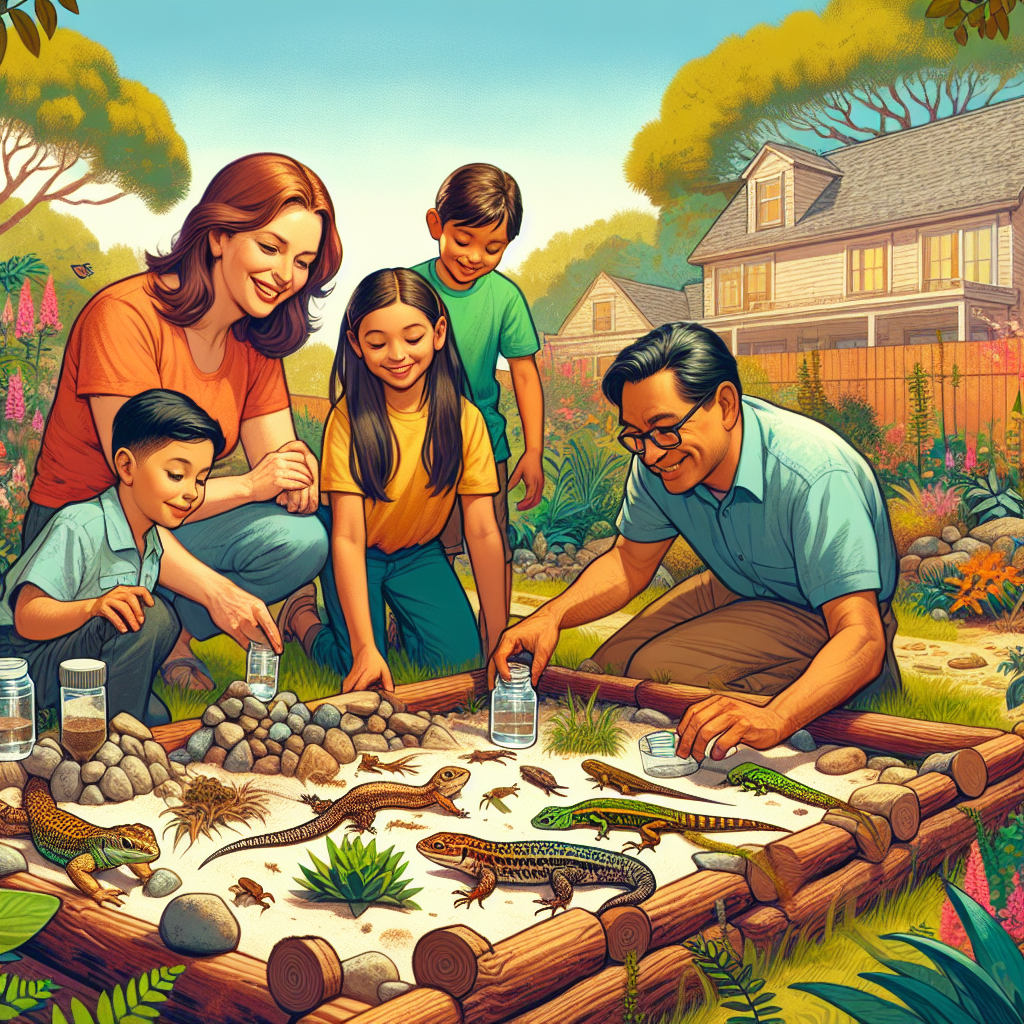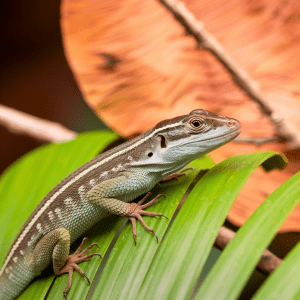Ever found yourself on vacation, enchanted by the buzz of lizards scurrying through an exotic garden, and wondered how to replicate such a vibrant ecosystem back home? Do your kids find themselves captivated by the amazing world of these nimble creatures? You're not alone! The beauty of forming a mini universe right in your backyard can be magical, especially one that's lizard-friendly.
Yes, you read that right. We're talking about lizard-friendly garden microhabitats. Now, you might be thinking, 'I don't know the first thing about creating such a habitat. Where do I start?' We've all been there, feeling a bit lost, which is why this guide is just the thing for you.
We aim to demystify the creation of these remarkable microhabitats, step by step, right from understanding their ecological importance to choosing the perfect garden spot to setting up structures and shelters. We're here to empower you to transform your garden into a mini haven for our cold-blooded friends.
And it's not rocket science; it's simpler than it sounds. This is your chance to engage the whole family in a fun, educational project that also supports local wildlife. So let's embark on this exciting journey together, one that promises to beautify your garden, delight your family, and create a thriving natural habitat for lizards. Starting a lizard-friendly garden microhabitat is like opening a captivating window to the world of ecology right in your backyard. Ready to jump in?
Explore the fascinating world of ‘Lizard-friendly garden microhabitats’ with this comprehensive guide tailored for parents and families with a love for nature. Through a transparent approach, this article empowers readers, particularly those lacking pertinent knowledge, to engage in an enriching family project: creating a thriving backyard ecosystem for our scaly friends. Highlighting ecological understanding, perfect garden spot selection, and habitat setup techniques, we invite you to embark on this journey towards enlivening your garden, supporting local wildlife, and opening an exciting window to ecology for your loved ones.
Understanding the Need for Lizard-friendly Garden Microhabitats: Connecting with Ecology
Planning Your Lizard-Friendly Garden Microhabitat
Creating lizard-friendly garden microhabitats is a fantastic family activity that combines out-of-the-box thinking, creativity and hands-on learning. It's also surprisingly simpler than you might think. Let's dive straight into it!
Start with Research
Getting to know the type of lizard species local to your area is paramount. These scaly garden guests have varying requirements in terms of food, shelter, and habitat preferences. For instance, some lizards love rocky terrains, while others prefer foliage. A quick online search can yield a wealth of information about the likes and dislikes of your neighborhood lizards. So, it’s time to get googling. Believe me, you'll be surprised at what you'll find out!
Choose an Appropriate Spot
Next, identify a suitable spot in your garden where you can create a lizard-friendly microhabitat. Ideally, select a location that gets a balance of sun and shade throughout the day. Lizards are ectothermic, meaning they regulate their body temperature using the environment. Having both a sunlit and shaded area caters to this need. This may sound daunting, but you're getting the hang of it already, aren't you?
Gather the Required Materials
To build lizard-friendly garden microhabitats, you'll need some essential items. This includes rocks and logs for shelter, a small pond or watering hole (a shallow dish will do just fine), and native plants that attract insects – a prime food source. In addition, don't forget to include some sandy or dry soil for basking areas. Why not turn this step into an exciting scavenger hunt with the kids?
Arrange Your Microhabitat
Finally, arrange the different elements in your chosen spot. Remember, it's essential to replicate a lizard's natural environment as closely as possible. So, have the kids help you pile up rocks and logs, plant the vegetation, and install the pond. It won't just be fun, but also highly educational. Go ahead, get your hands a little dirty, and watch the magic unfold!
By following these steps, you'll create not only a haven for lizards, but also an exciting educational tool for your family. Yes, it's that simple! Trust me, building lizard-friendly garden microhabitats will not only fuel your adventurous spirit but also ignite the curiosity of your little ones. Ready to give it a shot this weekend?
This how-to guide, targeted at families looking for a fun and educational activity, offers step-by-step instructions on creating "Lizard-friendly garden microhabitats." This engaging task involves researching local lizard species, choosing a suitable garden spot, gathering necessary materials, and arranging your microhabitat. It's not only a unique way to foster an appreciation for wildlife among children but also a brilliant method to support local biodiversity. Enjoy the thrill of seeing your backyard turn into a sanctuary for local lizards, while promoting a hands-on learning experience for your little ones.
Choosing the Right Location in your Garden for a Lizard-friendly Microhabitat
Step 1: Planning Your Lizard-friendly Garden Microhabitats
Let's start with the first crucial stage: planning your search for lizard-friendly garden microhabitats. Firstly, learn about the kinds of lizards local to your area or your travel destinations. Some useful resources include travel guides, online forums, and local wildlife centers. Acquainting yourself with the particular species can help you recognize what type of environment they prefer.
For instance, some lizards enjoy basking in the sun, while others prefer hiding in cool, shadowed areas. By understanding their preferences, you'll have a more grasping concept of how to spot and create suitable microhabitats within your garden. So, make it your mission this week to do some reptile research.
Step 2: Preparing a Suitable Environment
After you've conducted your research, you can now arrange your space to cater to your scaly friends. Start creating your lizard-friendly garden microhabitats by providing elements such as rocks for basking, leaf piles for seeking refuge, and water sources for hydration.
Transform your garden into a lizard paradise by installing features like low shrubs and dense foliage for them to explore. Furthermore, a diverse garden will not only entice lizards but can also enrich your family's gardening experience. Give it a shot this weekend and bear in mind, the key is to mimic the natural habitat of the lizards as closely as possible.
Step 3: Maintenance of the Habitat
Once you've set up your lizard-friendly garden microhabitats, it's essential to maintain them. This means frequently checking on water sources, ensuring leaf piles and rocks are in good condition, and removing any toxic substances that may harm the lizards. Similarly, make sure the microhabitats remain a safe distance from domestic pets who might not be as enthusiastic about your new reptilian neighbors.
Remember, consistency is key. Just like nurturing a garden, promoting a microhabitat requires time and patience. It may take a while for the lizards to discover and trust this safe space. However, with persistence, you'll soon witness a thriving ecosystem right in your backyard. So, consider these steps this week, not only for an enriching travel experience but also for an enlightening lesson in wildlife conservation for your family.
This guide, targeting environmental enthusiasts and avid gardeners, aims to harness reliable strategies for creating "Lizard-friendly garden microhabitats". Commencing with research on local lizard species and their preferences, the process advances to designing a suitable environment filled with rocks, foliage, water sources, and other essentials to mimic their natural habitat. The importance of consistent upkeep is underscored, involving regular checking on habitat conditions and eliminating potential threats. The article not only promises an engrossing garden renovation project, but also an opportunity for families to better understand and actively contribute to wildlife conservation in a personal, meaningful way.
Assembling the Basics: Key Elements for Creating Lizard-friendly Garden Microhabitats

A Step-by-step Guide to Creating Lizard-Friendly Garden Microhabitats
Building lizard-friendly garden microhabitats can be a fun-filled educational project for your family. Consider it a mini vacation where you get to create a welcoming environment for little lizard friends in your own backyard. Sounds exciting, right? Here's a guide to get you started.
1. Choose the Right Spot
Obviously, the first step involves finding an ideal location in your garden. Scout your garden for a quiet corner, preferably with access to some sunshine since lizards enjoy basking. Yet, you also want to ensure there's enough shade for those scorching summer days.
2. Use Natural Elements
Next, gather some natural elements. Remember, lizards love rocky and woody structures as they help them feel safe. A pile of stones or a few pieces of logs could be just what you need. Arrange these components to create a microhabitat that mimics a lizard's natural environment. Make sure not to compact the rocks or wood too close together. Lizards prefer a little wiggle room.
3. Incorporate Plants
Adding plants to your lizard-friendly garden microhabitats brings in an element of greenery and provides additional cover. For instance, go for native vegetation or plants with dense foliage. This will not only provide a cozy home for the lizards, but these plants could attract the insects that lizards feed on.
4. Provide Water Source
Lastly, we should not forget their need for hydration. A shallow dish filled with fresh water should suffice. Furthermore, ensure the water source is easy to access but also shaded from the sun to prevent it from getting too warm.
Creating lizard-friendly garden microhabitats can be as fulfilling for us as it is essential for these little creatures. It's a simple way to introduce your family to the fascinating world of lizards. Give it a try this week and experience the joy of inviting biodiversity into your backyard. You'll appreciate this fantastic learning experience as much as the lizards will!
This How-To Guide is designed for families seeking to engage in a fun educational project by creating lizard-friendly garden microhabitats. Through this activity, not only will families enjoy designing and constructing a valuable ecological niche, but they will also invite biodiversity into their own backyards. The article provides detailed steps on how to choose the ideal location, use natural elements for shelter, incorporate native plants for cover and food, and provide a water source in the microhabitat, all tailored to attract and sustain our tiny lizard friends. This guide emphasizes engaging with nature and learning about lizards, promising an enjoyable and meaningful experience for all family members.
Importance of Plant Species Selection for Lizard-friendly Garden Microhabitats
Creating a Safe and Appealing Environment
It's important to realize that when creating "lizard-friendly garden microhabitats", the environment needs to be both safe and attractive. Lizards are delicate creatures, and their habitat should reflect that. Start by choosing an area in your garden where they'd feel safe, perhaps near a rockery or underneath a shrub.
Setting up plywood or a sheet of corrugated iron near your chosen area will create a warm spot for them to bask during the day. In addition to this, creating a rock garden nearby will provide lizards with ample hiding spots. I tried this with my littles ones and they were fun-hunting lizards every other day in no time!
Developing a Balance Ecosystem
One of the challenges when setting up "lizard-friendly garden microhabitats" is creating a balanced ecosystem. After all, we want lizards to feel at home and for their presence to benefit the garden. For instance, the presence of too many predators, such as cats, can deter lizards. On the other hand, a garden that is too sterile won’t provide enough food (insects) for our reptilian friends. Therefore, maintaining a balance is key. You'll appreciate this little trick – planting native flora attracts local insect species, which in turn cater to a lizard’s diet.
Ongoing Improvements and Observation
Remember, the perfect habitat won’t be created overnight. Make little changes every now and again, and observe how they affect the overall environment. You might have to adjust the placement of the basking spot if it doesn't attract enough sunlight, or add more hiding spots if predators become a problem.
Finally, patience is a virtue when you're waiting for lizards to inhabit your garden. It might take weeks or even months. However, when you finally see a lizard basking in the spot you prepared, you'll understand that it’s more than worth the wait. So give it a shot this week and enjoy the process as you bring a bit of the wild into your backyard and create an unforgettable experience for your family.
Catering to gardening enthusiasts and nature lovers keen on creating ecological balance within their own backyards, this How-To Guide offers a step-by-step approach towards the creation of "lizard-friendly garden microhabitats." The guide dives into a comprehensive approach for setting up safe and appealing spaces within your garden for lizards, alongside sharing vital insights on maintaining a balanced ecosystem that benefits both lizards and the overall garden health. The reader is encouraged to embrace patience and observation, steadily improving the habitat to perfectly suit our reptilian friends over time. Ultimately, the article promises an enriching experience of bringing a bit of wilderness into your home garden and creating memorable moments for the whole family.
Building Structures and Providing Shelter: Making your Garden a Lizard-friendly Haven
Identifying Suitable Location
The first action step towards creating awesome, lizard-friendly garden microhabitats is selecting the right spot. Sure, it might seem simple, but trust me, the location plays a big role in meeting our scaley friends' needs. You want to select an area that is partially sunny and partially shaded.
Why? Most lizards like to bask in the sun for a portion of the day; however, they also need a shaded area to cool down. Thus, a space under a tree or near a garden structure will do the trick! And remember, variation in temperature is quite crucial for these cold-blooded creatures. You'll be amazed at how this simple step can quickly turn your garden into a lizard-lovers paradise!
Installing Shelter and Basking Sites
Next, offer shelter and basking sites. Lizards love places where they can hide and feel safe. This could be a pile of rocks, a patch of dense vegetation, or even a well-placed garden gnome, for instance! To create a cozy basking area, place flat rocks in sunny portions of your garden. Yes, it’s as easy as that!
In addition to this, incorporating logs with hollows or undercuts can make your scaly friends feel more at home. Just think about their natural environment and try to replicate it. Now, you're not just enhancing your garden aesthetics but also providing a safe haven for lizards.
Providing Food and Water
Finally, make sure you have a water source and a sufficient supply of food. Lizards, like people, need water to survive. A shallow dish of water will meet this need, and it's straightforward to maintain! In terms of food, lizards enjoy feasting on insects. Plant native flowering plants to attract those insects, and you'll have a self-sustaining lizard buffet! Give this delightful little strategy a try this weekend.
Constructing lizard-friendly garden microhabitats isn't just an imaginative way of engaging your curious kids, but it also helps in balancing your garden's ecosystem. The lizards, in return, help control pests like slugs, spiders, and harmful insects in your garden. It's a simple yet rewarding routine, and you'll enjoy the mutual benefits immensely. Who knows? You might just inspire others in your neighborhood to create their own lizard-friendly zones too! It's a fun family project, filled with learning and excitement. Why not give it a shot?
This guide will enlighten garden enthusiasts on making their backyards a haven for lizards by creating lizard-friendly garden microhabitats. The roadmap to achieving this includes identifying a suitable location with a balance of sunlight and shade, installing shelters and basking sites using natural elements like rocks and logs, and providing both food and water resources. The purpose of this endeavor isn't only to foster a learning experience for the family, but also to reap ecological benefits within the garden, such as pest control. The content is strategically crafted to engage readers, inspire action, and reflect our core principles of promoting greener and more sustainable lifestyles.
Maintaining and Monitoring your Lizard-friendly Garden Microhabitat: Valuable Tips and Tricks
Steps to Create Lizard-Friendly Garden Microhabitats
Crafting lizard-friendly garden microhabitats can be an engaging family activity. Yes, a fun and environment-friendly way to create a unique corner in your home garden even when you're low on expertise. Let's see how you can transform your garden space to welcome these tiny creatures:
Step 1: Identify & Prep Your Garden Space
First things first, choose a suitable, partially shaded spot in your garden. Consider a space with a mix of sun, shade and coaxing greenery. In fact, opt for a patch near large, rough-surface rocks that common garden lizards can hide under. You don't need a huge space; just a reasonable area will do. Let's aim for this weekend to complete the prep work!
Step 2: Create Variations in the Environment
Now, it's about strategizing the micro environment. Lizards adore diversity, so mixing some sand into the soil and providing an area with small rocks can benefit them. For instance, a small slope or a miniature hill can provide a gradient in temperature and humidity, perfect for these little dwellers. Bring a slight variation; you'll be amazed to see what it can attract!
Step 3: Plant Selection
One of the visible challenges can be deciding on the plants. Seemingly intimidating, but not quite as tough as it appears. Lizards love native plants that, in addition to providing them cover, attract the insects they feed on. Pair your favorite local flowering species with a few dry-grass patches! Give it a fresh start this Tuesday or even better, today itself.
Step 4: Providing Water Source
In your lizard-friendly garden microhabitats, water is a crucial element. A shallow bowl or a saucer with water can act as a waterhole. Make it a point to change the water regularly to prevent mosquito breeding. This tiny step can indeed rope in a bundle of joy!
There you have it, a simple blueprint to create your very own lizard-friendly garden microhabitats. It’s engaging, it’s fun, and it takes you a notch closer to Mother Nature. So, why wait? Let this weekend be all about your garden adventure!
This How-To Guide aims to assist gardening enthusiasts and nature lovers in creating "Lizard-friendly garden microhabitats" in their home gardens. The guide provides easy-to-follow steps, from identifying and preparing the perfect garden space to plant selection and water provision to accommodate and attract these tiny creatures. Drawing on the tone of the article, the summary emphasizes the joy and engagement in creating microhabitats, advocating a fun, hands-on weekend family activity that uniquely marries gardening with local wildlife conservation.
Fun Family Activities Around Your Lizard-Friendly Garden Microhabitat: Engaging the Next Generation in Conservation
Embrace the Challenge
Creating a lizard-friendly garden microhabitat can be a fun, educational exercise for the entire family. No need for a degree in wildlife science– just follow these simple steps, and you'll see incredible transformations in your garden that the kids will love.
Step 1. Choosing the Right Location
Choosing the right location is essential to create meaningful garden microhabitats. Areas that provide a blend of sun and shade are a nice pick since lizards thrive in such environments. However, also make sure the spot isn't prone to flooding during rainstorms. Give it a shot this weekend. Even a small section of your garden can be transformed into a thriving habitat.
Step 2. Providing Shelter
Next up, think about providing shelter. This can be as simple as stacking some rocks or logs in a safe, stable manner to serve as a hiding place. Kids will find it fascinating to watch lizards dart in and out of these hideaways. Try incorporating this step into your next gardening session with the family!
Step 3: Growth With Purpose
Plant with intention! Suitable plants and shrubs add visually to your garden and provide vital spaces for lizards to hunt and hide. Opt for native plants since they're more likely to attract local insects that lizards feast on. For instance, ferns and succulents can create excellent undergrowth where lizards can hunt while also providing privacy. Remember to keep pesticide use to a minimum, as it can deter the lizards from making your garden their home.
Step 4: Maintaining Your Microhabitat
Maintaining your lizard-friendly garden microhabitats involves regular check-ups- ensuring that the plants are healthy and hideaways are stable. Have patience, it could be a while before our reptilian friends find your garden. But once they do, observing their interactions can be an incredible family bonding experience.
By following these steps, you’ll have created a living, breathing ecosystem right in your backyard and kindle your family's interest in nature and wildlife. Go on, roll up those sleeves and get the kids involved – start building your lizard-friendly garden microhabitats today. Creating something together can often be the best part of a family vacation!
Unleash your inner wildlife enthusiast and transform your backyard into an exciting ecosystem with our simple guide to creating lizard-friendly garden microhabitats. With a focus on family participation, this article provides easy-to-follow instructions on selecting the ideal location, setting up shelters, choosing the right plants, and maintaining the habitat in your own garden. It's all about creating educational, engaging experiences for kids while promoting an appreciation for nature and wildlife. Discover the joy of cultivating a dynamic, lizard-friendly microenvironment, complete with scurrying lizards, right at home!
So you've embarked on the fascinating journey into the world of lizard-friendly garden microhabitats, learning the significance of local biodiversity and crafting a sanctuary for our scaled friends right in your backyard. Isn't it extraordinary that with a bit of effort, a pinch of creativity, and a dash of patience, your family could transform a small green space into a thriving micro-ecosystem?
By now, you should have a deeper understanding of these captivating creatures and their habitat preferences. You've seen how natural shelters, native vegetation, and good old sunlight can make an inviting retreat for the local lizard population. But remember, just as we love our homes, these tiny inhabitants need a tune-up from time to time, so keeping the habitat maintained is crucial. Ultimately, it’s about creating and preserving that magical balance between the needs of your backyard residents and the health of the garden as a whole.
On that note, why not take the knowledge and inspiration gained from this guide and make this more than just a one-time family activity? Let these microhabitats become ever-evolving projects, teaching the kids about responsibility, environmental stewardship, and the beauty of nature. With this newfound expertise in crafting lizard-friendly garden microhabitats, you'll be bringing a slice of wilderness to your backyard, engaging the family in a rewarding endeavor and contributing to local wildlife conservation. As you continue this exploration, remember that every little action helps, and you're making a world of difference, one lizard-friendly microhabitat at a time.



